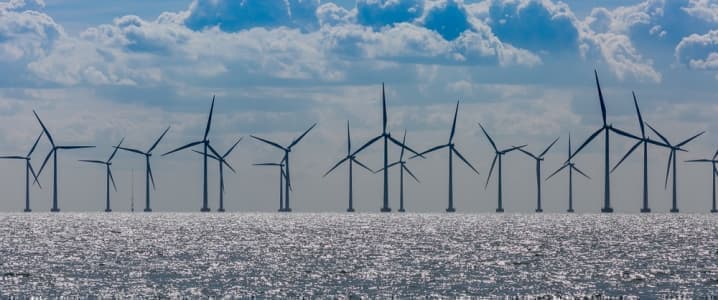The global wind industry is expected to become a $1 trillion business, according to the International Energy Agency. The industry will grow by 13 percent per year, passing 20 GW of annual installations by 2030.
Around 150 new offshore wind projects are expected to move forward in the next five years.
The nascent industry is still far behind other sources of energy, including other renewables. But the potential is nearly limitless. “The best offshore wind sites could supply more than the total amount of electricity consumed worldwide today,” the IEA said in its report. “And that would involve tapping only the sites close to shores.”
In a lengthy report spotlighting offshore wind, the IEA found that the total technical potential for the industry is 36,000 TWh per year for installations in waters less than 60 meters deep and within 60 kilometers from shore. That compares to total global electricity demand of 23,000 TWh.
But offshore wind can also go deeper and farther from shore. The IEA said that floating offshore wind alone has the potential to meet the world’s electricity 11 times over in 2040.
Still, it is early days, and total capacity additions only topped 4 GW in 2018.

(Click to enlarge)
Nevertheless, the agency highlighted a long list of attractive features that make offshore wind so promising.
Wind projects onshore have lower capacity factors, which means that they do not generate power in all hours of the day. Offshore, the winds are stronger and more consistent, giving offshore wind an average capacity factor of between 40 and 50 percent. “Offshore wind’s high capacity factors and lower variability make its system value comparable to baseload technologies, placing it in a category of its own – a variable baseload technology,” the IEA said. Offshore wind also tends to produce more electricity in winter months in the U.S., Europe and China, which makes it more useful than onshore wind and solar. Related: Iran’s $280 Billion Sanction Skirting Scheme
On top of that, offshore wind avoids all the land use conflict that so many other energy sources carry.
In addition, there are “synergies” between offshore wind and offshore oil and gas. The IEA says that about 40 percent of the full lifetime cost of an offshore wind project has overlaps with oil projects. Companies building foundations and subsea structures for oil and gas, for instance, can do the same for offshore wind. The same is true for maintenance and inspection of offshore structures.
Of course, much depends on cost. Offshore wind is behind, with the levelized cost of electricity averaging $140/MWh in 2018, far higher than gas, coal and other renewables. But costs are coming down. “Offshore wind is set to be competitive with fossil fuels within the next decade, as well as with other renewables including solar PV,” the IEA said. Financing costs account for 35 to 50 percent of the cost of a project, leaving plenty of room for improvement. The agency said costs could fall to $60/MWh by 2030 and $45/MWh by 2040 if financing costs come down.
In Europe, offshore wind is already competitive. The results from recent auctions suggest that offshore wind will soon beat out natural gas, and will be roughly even with solar and onshore wind, the IEA said. One project in France had a strike price of just $50/MWh, although it did not include transmission.
Europe pioneered offshore wind, and remains a key stronghold. Denmark produced 15 percent of its electricity from offshore wind last year. However, as is the case with most discussions revolving around every energy source, China is playing an increasingly important role. In 2018, China added more offshore wind than any other country.
For now, though, the major companies are European, including Ørsted, RWE and Vattenfall. 10 of the 15 largest companies by market share are from Europe, although China Longyuan ranks third. Only one in the top 15 is from the U.S. – Global Infrastructure Partners – and it is an investor rather than a developer. Related: Oil Rig Count Plunges To Lowest Level Since 2017
Still, despite offshore wind’s potential, the pace of growth is not fast enough to meet global climate targets. The IEA said that deployment needs to accelerate to around 40 GW of annual installations by the 2030s, which would translate to $1.2 trillion in cumulative investment over the next two decades. Based on current trends, the agency only sees annual installations topping 20 GW by then with cumulative investment reaching $840 billion.

(Click to enlarge)
There are some major hurdles that will require more accommodative policy support from governments. The industry still needs to build out supply chains, construction capacity for ever-larger turbines, larger vessels, onshore grid infrastructure and transmission lines connecting turbines to the shore. There is a bit of a chicken-and-egg problem between all of these moving pieces; the lack of each is slowing progress on other aspects.
But the bottom line is that offshore wind has the potential to be a “game-changer,” according to the IEA.
“In the past decade, two major areas of technological innovation have been game-changers in the energy system by substantially driving down costs: the shale revolution and the rise of solar PV,” said Dr. Fatih Birol, the IEA’s Executive Director. “And offshore wind has the potential to join their ranks in terms of steep cost reduction.”
By Nick Cunningham of Oilprice.com
More Top Reads From Oilprice.com:
- Oil Rebounds On Rare Market Optimism
- Trump Vows To Protect Syrian Oil Fields From ISIS
- Floating Nuclear Power: Chernobyl On Ice Or The Future Of Energy?


















